In the last years, the use of biomass as alternative source of fuel has assumed great importance. Recent research activities showed the different routes of supply in this type of chain, highlighting the great potential of biomass in the bio-energy framework. Even materials apparently worthless such as pruning, stumps, and forest residues are now considered important sources of energy.
It is known also that the use of biomass reduce the dependency from fossil fuels, playing an important role for the reduction of CO2 emissions and the climate change mitigation. Among the available biomass resources, wood chip is probably the most common product used in biomass power plants.
However, the increasing demand of wood chip should be balanced by the creation of storage systems capable to assure its maintenance and improving the final characteristics of the product. Biomass storage has the aim to improve bio-fuel’s quality because it reduces the moisture content in woody materials and minimize losses of dry matter due to microbial degradation. Several studies have been carried out worldwide in order to identify storage methods able to minimize these problems.
Nowadays, the international literature on woodchips degradation shows that the material should be stored in pyramidal piles, under aerated sheds, and placed onto draining surfaces, preferably convex, like asphalt or cement . Alternatively, the piles can be covered with transpiring sheets such as Gore-Tex or Top-Tex.
On the basis of the CRA-ING experiences, the present work has been developed to show different storage methods using SRF comminuted poplar, which is a species not widely studied in this context. The purpose of the work is identification of the most efficient system that can be used to store poplar chips considering the storage logistics, the energy losses occurred during the storage period, and the quality of the final product. In addition, considering the importance of wood residues in the bio-energy scenario, the aim of this work is also that of evaluating the energy value of poplar residues coming from traditional plantations, which are represented by the tree crowns (branchwood). The study in this case was limited to the determination of chemical and physical characteristics possessed by crown and stem wood chips before storage; by comparing the energy value of the residues with stem wood (traditionally considered the most valuable), it will be possible to obtain information about the energetic potential of this product.
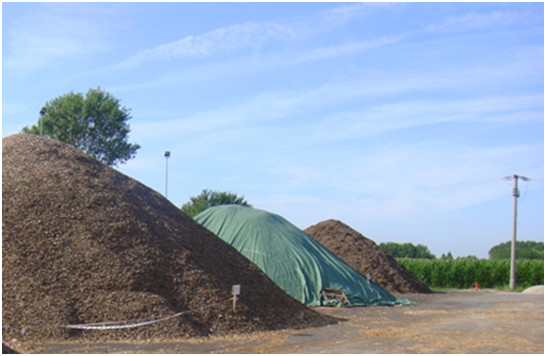 In the first test, six experimental piles of poplar chips were developed in order to evaluate the effects of the covering systems on chips in a long term period of storage. The piles, built on cemented surface, had a pyramidal form being 6 m tall and 10 m wide. Three of these were covered with a geotextile sheet; the others were left uncovered as control.
In the first test, six experimental piles of poplar chips were developed in order to evaluate the effects of the covering systems on chips in a long term period of storage. The piles, built on cemented surface, had a pyramidal form being 6 m tall and 10 m wide. Three of these were covered with a geotextile sheet; the others were left uncovered as control.
The internal heat development was monitored using 12 thermocouples for each pile located in specific areas at three different levels named L1, L2, L3 (respectively at 1, 2 and 4 m of height from the ground). The thermocouples were connected through a silicone cable to a central computer which communicated data every 10 second.
In addition, external climatic data such as precipitation, wind speed, external temperature, air humidity and solar radiation were monitored with a weather cab installed at the storage site.
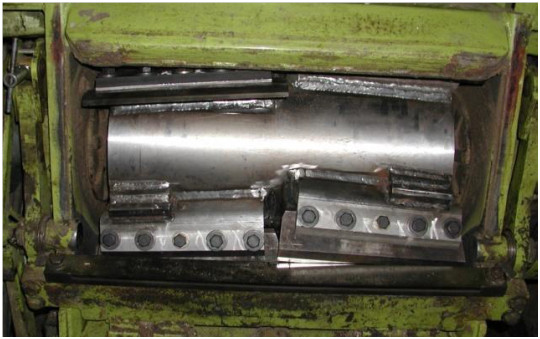 The second experimentation had the purpose to evaluate how the chip size influences the quality of storage. In this experiment, three piles having the same dimension of the previous were formed by SRF poplar chipped with a self-propelled forage harvester (Class Jaguar 890), while other three piles were formed chipping the plants with a self-propelled forage harvester with a modified chipping system.
The second experimentation had the purpose to evaluate how the chip size influences the quality of storage. In this experiment, three piles having the same dimension of the previous were formed by SRF poplar chipped with a self-propelled forage harvester (Class Jaguar 890), while other three piles were formed chipping the plants with a self-propelled forage harvester with a modified chipping system.
The modification introduced by CRA-ING consisted of 10 additional fixed blade tilted of 5° respect the rotational axis.
The measurements of internal and external parameters were monitored following the same logic of the previous trial.
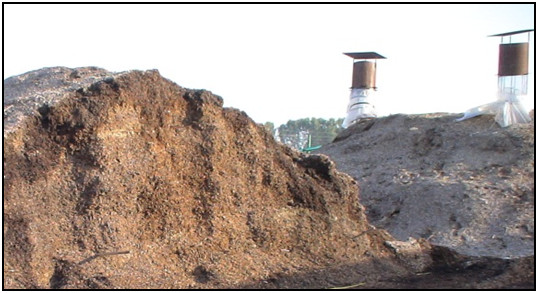 The third test was carried out in order to evaluate the effect of ventilation on chips during storage. In this case, for practical reasons, only one pile was built around a metallic structure consisting of a horizontal pipe connected to two vertical chimneys.
The third test was carried out in order to evaluate the effect of ventilation on chips during storage. In this case, for practical reasons, only one pile was built around a metallic structure consisting of a horizontal pipe connected to two vertical chimneys.
The system allowed the induction of air pumped with a fan with the purpose to speed up the drying process. Also in this experiment, the measurements of internal and external parameters were obtained following the same logic of the first study. The piles uncovered used in the first test were used as control.
Finally, six additional piles were created with comminuted wood coming from a traditional plantation (15 years old) dividing the material of crown from that of stems (three pile of comminuted crown and three of comminuted stem). These piles were left uncovered and the material was characterized in order to define the energetic performances of both chip kinds at the beginning of the test.
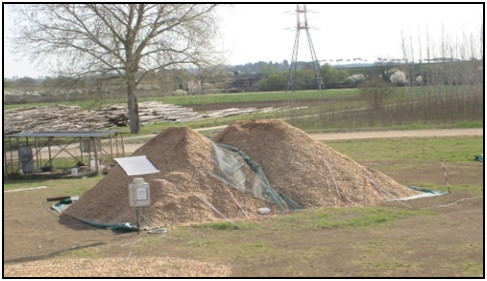 The parameters monitored in covered and uncovered piles have shown a very similar trend. This behavior was probably due the thickness of the external layer (30cm around) acting as a protective barrier in uncovered piles.
The parameters monitored in covered and uncovered piles have shown a very similar trend. This behavior was probably due the thickness of the external layer (30cm around) acting as a protective barrier in uncovered piles.
The results have shown that the dry matter losses in covered piles were the 7%, while the average moisture content of the chip dropped to 37%. In uncovered piles the dry matter losses were the 10%, while the average moisture content of chips reached the 35.5%. This indicates that the geotexile covering has not influenced the conservation of chips remarkably.
Furthermore, in both covered and uncovered piles the heating values of the chips remained similar, indicating that the quality of the product was not affected by the covering sheet. The mean ash content resulted lower in covered piles; probably it was due to the presence of inert material in uncovered piles.
In the second part of the study, the granulometric chip analysis showed that the use of the self propelled forage harvester with the chipping system modified by Panacea group has determined a statistically significant variation in the particle size distribution of chip. In fact, the modified machine has produced chips corresponding for the 65% to the middle size class, respect to 48% of the standard model.
In addition, the quantity of large size chips produced with the modified machine was double respect that produced with the standard configuration
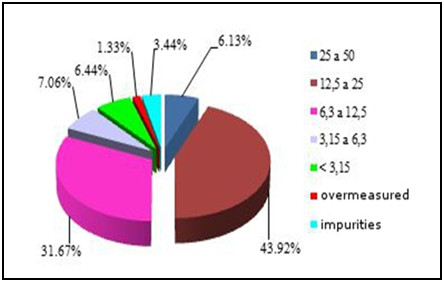
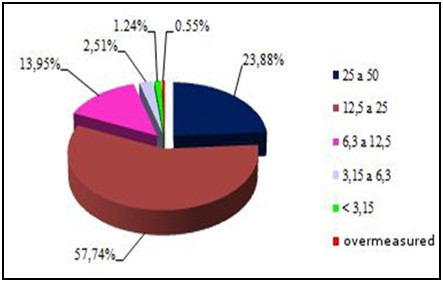
This storage test showed a different conservation capacity of the product according to the chipping system used. In fact, after 4 months of storage, the dry matter losses in chips obtained with the modified machine decreased dramatically in levels L1 and L2. On the other hand, the heating values and the ash content remained similar in both chip kinds (16200 Kj/Kg and 3,8 % respectively).
The storage carried out using the ventilating system did not give satisfactory results as chips dried well just in the area very close to the ventilating system, remaining wet and poor of energy value in the surrounding.
Finally, the study of the energy performance of stem wood and crown wood showed a different concentration of the Nitrogen content, which was about 30% higher in crown wood, having also a heating value slightly higher than that of stem. The other energy parameters (see table below) resulted similar indicating the good potential of poplar residues for energy production. Future studies will show the storage performance of this product in comparison with the stem wood chips.
|
Parameter |
|
Crown woodchips |
Stem woodchips |
|
Ash |
% s.s. |
2,91 ± 0,7 |
3,02 ± 0,3 |
|
Nitrogen |
% |
0,32 ± 0,03 |
0,21 ± 0,04 |
|
Carbon |
% |
47,7 ± 1,7 |
47,2 ± 2 |
|
Hydrogen |
% |
5,9 ± 0,4 |
5,96 ± 0,3 |
|
Sulfur |
% |
0,03 ± 0,01 |
0,03 ± 0,01 |
|
Higher heating value |
KJ/Kg |
16,28 ± 0,29 |
15,61 ± 0,64 |
|
Lower heating value |
KJ/Kg |
15,02 ± 0,31 |
14,34 ± 0,57 |
In conclusion, the pile covering during storage has determined dry matter losses slightly lower respect the uncovered system. However, results can change in relation to the environmental conditions; in fact, the same experiment reproduced in other periods has shown non-significant differences between the two methods. Indeed, the cost of the geotexile sheet (2euro/m2 and lifetime of 5 years) in our case did not justify the limited advantage furnished.
In the second part of the work, the experimentation demonstrated that it is possible to preserve the biomass increasing the chip size, because it determines a more rapid drying process creating a more hostile environment for microorganisms that rely on water to cause degradation. Indeed, the product in this case was quickly marketable. The storage with the ventilated system was unsuitable because the installation and the management costs resulted too high respect the benefit conferred to the product quality.
Finally, the last study demonstrated that from an energetic point of view, the characteristics of fresh poplar residues resemble those of stem wood, showing its good potentials in the perspective of using such a product as source of fuel.



